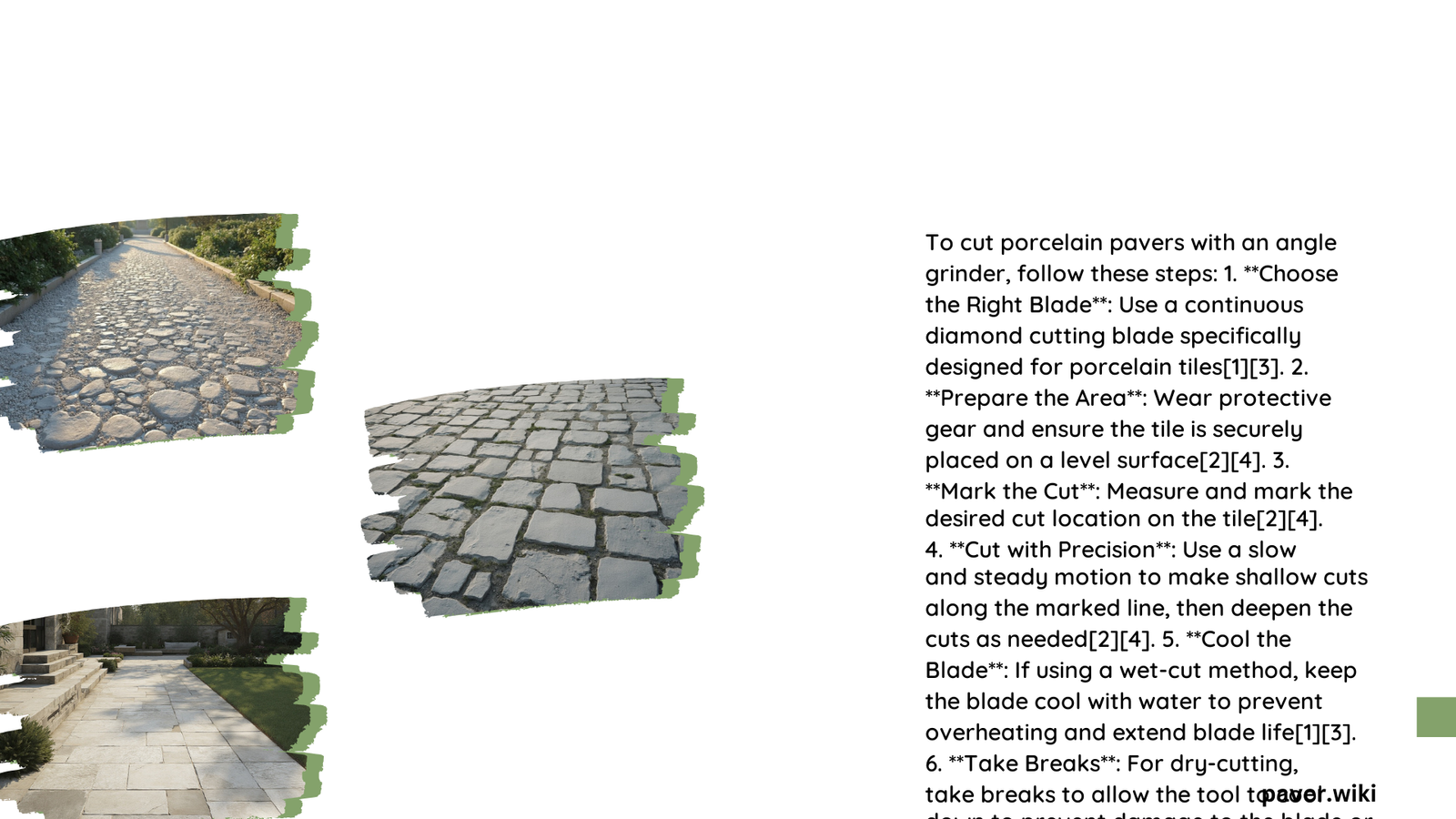Cutting porcelain pavers with an angle grinder requires precision, patience, and the right techniques. This guide provides step-by-step instructions for achieving clean, accurate cuts on porcelain pavers using an angle grinder. From selecting the proper blade to essential safety precautions, we cover all aspects of this process to help you achieve professional results in your paving projects.
What Equipment Do You Need for Cutting Porcelain Pavers?
Before diving into the cutting process, it’s crucial to gather the necessary tools and equipment:
- Angle grinder
- Continuous diamond cutting blade
- Measuring tape
- Chalk or pencil
- Clamps
- Plywood or straight edge
- Safety gear (dust mask, safety glasses, gloves)
- Old matting or vibration-absorbing material
- Water source for cooling (optional)
How Do You Prepare for Cutting Porcelain Pavers?

Proper preparation is key to achieving clean cuts on porcelain pavers. Follow these steps:
-
Measure and mark: Use a measuring tape to determine the desired cut line. Mark it clearly with chalk or a pencil.
-
Set up your workspace: Choose a flat, stable surface to work on. Place the paver on an old piece of matting to absorb vibrations.
-
Secure the paver: Use clamps to hold the paver in place. This prevents movement during cutting.
-
Attach the diamond blade: Install a continuous diamond cutting blade on your angle grinder. Ensure it’s securely fastened.
-
Don safety gear: Put on your dust mask, safety glasses, and gloves before starting the cutting process.
What’s the Best Technique for Cutting Porcelain Pavers with an Angle Grinder?
Follow this step-by-step guide for optimal results:
-
Score the cut line: Lightly run the angle grinder along the marked line, creating a shallow score about 1/16″ deep. This guides your subsequent cuts.
-
Set up a straight edge: Clamp a piece of plywood along the cut line to serve as a guide for the grinder.
-
Make the first pass: Run the grinder along the scored line, cutting about halfway through the paver. Use low revs and let the blade do the work without applying pressure.
-
Cool down: Pause to allow the blade and paver to cool. This prevents overheating and potential damage.
-
Complete the cut: Adjust your position and make a second pass to complete the cut through the paver.
-
Smooth the edges: If necessary, use the grinder to gently smooth any rough edges left by the cut.
How Can You Ensure Safety When Cutting Porcelain Pavers?
Safety should be your top priority when using an angle grinder. Here are essential safety tips:
- Always wear appropriate personal protective equipment (PPE).
- Ensure proper ventilation in your work area.
- Keep your work area clean and free of debris.
- Never force the grinder or apply excessive pressure.
- Take regular breaks to prevent fatigue and maintain focus.
- Keep the grinder’s cord away from the cutting area.
- Never use a damaged or worn-out blade.
What Are Common Mistakes to Avoid When Cutting Porcelain Pavers?
Avoid these common pitfalls for better results:
- Using the wrong blade type or size
- Cutting too quickly or applying too much pressure
- Neglecting to cool the blade and paver
- Failing to secure the paver properly
- Not wearing appropriate safety gear
- Attempting to make curved cuts without relief cuts
How Do You Handle Curved or Intricate Cuts on Porcelain Pavers?
For curved or complex cuts:
- Mark the desired shape clearly on the paver.
- Make tension relief cuts at each end of the curve, about 50-75mm long.
- Score along the curved line lightly.
- Make multiple shallow passes, gradually increasing depth.
- Take frequent breaks to cool the blade and paver.
- Use a smaller diameter blade for tighter curves if necessary.
What Are the Best Blades for Cutting Porcelain Pavers?
Choosing the right blade is crucial for clean cuts. Here’s a comparison of suitable blades:
| Blade Type | Pros | Cons | Best For |
|---|---|---|---|
| Continuous Rim Diamond | Smooth, chip-free cuts | More expensive | Precision cuts |
| Segmented Diamond | Faster cutting | May chip edges | Rough cuts, faster work |
| Turbo Diamond | Balance of speed and smoothness | Moderate chipping risk | General-purpose cutting |
How Do You Maintain Your Angle Grinder for Porcelain Paver Cutting?
Proper maintenance ensures longevity and performance:
- Clean the grinder after each use, removing dust and debris.
- Check and tighten all screws and fittings regularly.
- Inspect the power cord for any damage.
- Keep the air vents clear to prevent overheating.
- Replace worn brushes as needed.
- Store in a dry, clean place when not in use.
What Are Expert Tips for Perfect Porcelain Paver Cuts?
-
Practice on scrap pieces: Before cutting your actual pavers, practice on spare pieces to get a feel for the process.
-
Use a water source: If possible, have a helper spray water on the cutting area to reduce dust and keep the blade cool.
-
Take your time: Rushing the process often leads to mistakes. Work slowly and methodically for the best results.
-
Check your blade regularly: A dull blade can cause chipping and poor cuts. Replace it when necessary.
-
Consider the paver thickness: Adjust your cutting technique based on the thickness of the paver. Thicker pavers may require multiple passes.
By following these guidelines and tips, you can effectively cut porcelain pavers with an angle grinder, achieving clean, precise results for your paving projects.
References:
1. How To Cut Outdoor Porcelain Pavers To Ensure a Perfect Fit – Tile Tech Pavers
2. How To Cut Porcelain Paving With A Grinder – YouTube
3. How To Cut – Porcelain Paving – YouTube
4. Cutting Porcelain Tile Without Chipping: Tips and Techniques – LX Hausys
5. How to cut porcelain slabs with an angle grinder – YouTube
